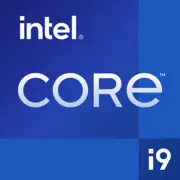Intel Core i9-10900X

Intel Core i9-10900X: Review and Relevance in 2025
Introduction
The Intel Core i9-10900X processor, released in late 2019, is still in demand in certain segments of the market. Despite its age, it offers 10 cores and 20 threads, making it an interesting solution for professionals. In this article, we will explore how relevant this CPU is in 2025, what tasks it can handle, and who should consider it.
1. Key Specifications: Cascade Lake Architecture
Architecture and Manufacturing Process
The Core i9-10900X is built on the Cascade Lake-X microarchitecture (14 nm). By 2025, the 14-nm process looks outdated compared to the 5-nm and 7-nm chips from AMD and Intel, but it still demonstrates decent performance for multi-threaded workloads.
Performance
- Frequencies: Base frequency — 3.7 GHz, maximum Turbo Boost — 4.5 GHz (for a single core).
- Cache: 20 MB L3.
- Benchmarks: In Geekbench 6 Single-Core — 1566, Multi-Core — 9308. For comparison, the modern Ryzen 9 7900X (2023) scores ~2300/18000, but the i9-10900X still outperforms many budget 8-core CPUs.
Key Features
- Supports PCIe 3.0 (44 lanes).
- Intel Turbo Boost Max 3.0 and Hyper-Threading technologies.
- Compatible with motherboards using the X299 chipset, allowing for quad-channel memory.
2. Compatible Motherboards
Socket and Chipsets
The processor uses the LGA 2066 socket. Compatible chipsets are Intel X299. In 2025, such motherboards are still available but mainly on the secondary market or as leftovers. Examples of models include:
- ASUS ROG Rampage VI Extreme (price in 2025: ~$250-300 for new, if found).
- Gigabyte X299 AORUS Ultra Gaming Pro (~$200-250).
Selection Criteria
- Overclocking: Motherboards with strong VRM (e.g., ASUS WS X299 Sage) are suitable for stable overclocking.
- Ports: Ensure availability of USB 3.2 Gen2, M.2 for NVMe.
- BIOS: Check compatibility with the i9-10900X when purchasing a new board — a firmware update may be required.
3. Supported Memory Types
DDR4 — The Main Standard
- Frequencies: Up to 2933 MHz (officially), but many boards support overclocking to 3600+ MHz.
- Modes: Quad-channel is an advantage of X299 over mainstream platforms.
- Recommendations: 32-64 GB (4x8 GB or 4x16 GB) for work tasks.
DDR5 Not Supported
This is the main drawback in 2025. If you plan to upgrade to DDR5, the i9-10900X is not for you.
4. Power Supply Units: Power Calculation
TDP and Power Consumption
- Nominal TDP — 165 W, but with overclocking, consumption can reach 250 W.
- Recommendations: A power supply of 750 W with an 80+ Gold certificate. Examples:
- Corsair RM750x (2025) — $120-140.
- Seasonic Focus GX-850 — $150.
Important: Don't skimp on the PSU — high loads require stable voltage.
5. Pros and Cons
Pros
- High multi-threaded performance for rendering and encoding.
- Quad-channel memory increases bandwidth.
- Relatively low price (~$400-450 for new in 2025) compared to modern HEDT processors.
Cons
- Lacks PCIe 4.0/5.0 and DDR5 support.
- High power consumption and heat generation.
- Outdated LGA 2066 socket with no upgrade path.
6. Use Cases
Work Tasks
- 3D Rendering (Blender, V-Ray): 10 cores perform better than 8-core Ryzen 5.
- Video Editing (Premiere Pro): Rendering 4K videos takes 15-20% less time than with the i7-10700K.
Gaming
- In AAA titles (Cyberpunk 2077, Starfield), the CPU shows 90-120 FPS paired with an RTX 4070 Ti, but lags behind the Ryzen 7 7800X3D due to lower IPC.
Multimedia
- Streaming (OBS + gaming) runs smoothly thanks to 20 threads.
7. Comparison with Competitors
AMD Ryzen 9 5900X (12 Cores, 24 Threads)
- Pros: Better energy efficiency (105 W), support for PCIe 4.0.
- Cons: Dual-channel memory. Price in 2025: ~$350.
Intel Core i7-12700K (12 Cores, 20 Threads)
- Pros: Higher IPC, supports DDR5.
- Cons: More expensive (~$400), requires motherboard replacement.
Conclusion: The i9-10900X is advantageous only if you already have an LGA 2066 socket or need quad-channel memory.
8. Practical Assembly Tips
- Cooling: Use an AIO cooler (e.g., NZXT Kraken X63) or a top-tier air cooler (Noctua NH-D15).
- Case: At least 3 fans for ventilation. Example — Lian Li Lancool III ($150).
- Storage: NVMe SSD (Samsung 990 Pro 2 TB) + HDD for archiving.
9. Final Conclusion: Who Should Consider the i9-10900X?
This processor is worth considering if:
1. You already have an X299 motherboard and want an upgrade without changing platforms.
2. You need quad-channel memory for work tasks.
3. Your budget is limited and multi-threaded performance is a priority.
Alternative: For new builds, it is better to choose the Ryzen 9 7900X or Intel Core i5-14600K — they offer modern technologies (DDR5, PCIe 5.0) at a comparable price.
Conclusion
In 2025, the Intel Core i9-10900X is a niche solution. It lags behind new CPUs in energy efficiency and support for current standards, but remains a workhorse for professionals locked into the LGA 2066 platform. It is advisable to purchase it only if there are specific requirements and a limited budget.
Basic
CPU Specifications
Memory Specifications
GPU Specifications
Miscellaneous
Benchmarks
Compared to Other CPU
Share in social media
Or Link To Us
<a href="https://cputronic.com/cpu/intel-core-i9-10900x" target="_blank">Intel Core i9-10900X</a>